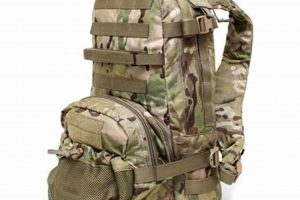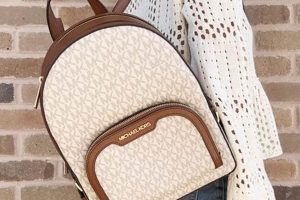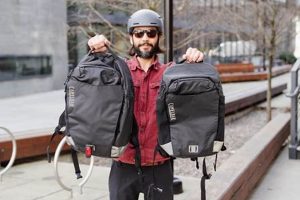These specialized carriers are designed for transporting gear and supplies on outdoor excursions. These carrying systems typically feature a durable frame, padded shoulder straps, and a waist belt to distribute weight effectively, enhancing comfort and stability during hiking, camping, and backpacking activities.
The utility of these load-bearing systems lies in their ability to enable individuals to carry substantial weight over extended distances, facilitating self-sufficiency and exploration of remote locations. Throughout history, the evolution of these carrying systems has significantly impacted exploration, trade, and recreational pursuits by enabling access to previously inaccessible areas.
The following sections will delve into the specific features, construction materials, and selection considerations relevant to understanding these essential pieces of equipment, enabling informed decisions for outdoor pursuits.
Selecting and Utilizing Backpacks Effectively
The following are crucial guidelines for optimizing the selection, fitting, and usage of load-bearing packs to maximize comfort and performance during outdoor activities.
Tip 1: Size Appropriately: Torso length, not height, dictates pack size. Measure torso length from the iliac crest to the C7 vertebra to determine the correct pack size. Incorrect sizing leads to improper weight distribution and discomfort.
Tip 2: Prioritize Fit: A properly fitted pack rests comfortably on the hips, transferring weight effectively. Adjust shoulder straps, hip belt, and load lifters to achieve a snug, balanced fit. Seek professional fitting assistance at outdoor retailers if needed.
Tip 3: Distribute Weight Evenly: Pack heavier items close to the spine and between the shoulder blades for optimal balance. Lighter items can be placed in the outer compartments. Uneven weight distribution can lead to instability and fatigue.
Tip 4: Utilize Compression Straps: Compression straps secure the load and prevent shifting, maintaining balance and reducing strain. Tighten straps after packing to minimize movement within the pack.
Tip 5: Adjust Load Lifters: Load lifters connect the shoulder straps to the top of the pack frame. Adjust them to a 45-degree angle to pull the pack closer to the body and improve weight distribution. Avoid over-tightening, which can restrict movement.
Tip 6: Practice Packing: Familiarize with the pack’s features and compartments. Practice packing and unpacking before trips to ensure efficient organization and accessibility.
Tip 7: Inspect and Maintain: Regularly inspect the pack for damage, such as tears or broken buckles. Clean the pack after use and store it in a dry place to prolong its lifespan. Proper maintenance ensures the pack’s longevity and reliability.
Adhering to these guidelines will result in a more comfortable and efficient backpacking experience, minimizing strain and maximizing enjoyment of outdoor pursuits.
The subsequent sections will explore specific models and their suitability for various activities, aiding in the final selection process.
1. Durability
Durability is a cornerstone of the carrying systems’ product line, directly influencing their longevity and suitability for rigorous outdoor use. The use of robust materials, reinforced stitching, and heavy-duty zippers contributes to the ability of these systems to withstand abrasion, tearing, and the stresses associated with carrying heavy loads over varied terrain. Without adequate durability, a carrying system would be prone to failure, potentially compromising the safety and comfort of the user during wilderness excursions.
For instance, the use of high-denier nylon fabrics in the main pack body, coupled with reinforced bottom panels, is a common design feature that enhances resistance to wear and tear. Similarly, stress points, such as shoulder strap attachments and hip belt connections, are often reinforced with bar-tack stitching to prevent premature failure under heavy loads. The implementation of weather-resistant coatings and durable water repellent (DWR) finishes further enhances durability by protecting the pack from moisture and environmental degradation.
Ultimately, the commitment to durability in these products translates into reliable performance and extended product lifespan. This is particularly important for serious backpackers and outdoor enthusiasts who rely on their equipment to perform consistently in challenging conditions. The brand’s reputation for producing durable and reliable systems directly influences consumer trust and purchase decisions, emphasizing the practical significance of this attribute.
2. Capacity.
Capacity, measured in liters, is a fundamental attribute of these carrying systems, directly correlating to the volume of gear an individual can transport. This capacity ranges significantly across product lines, from smaller daypacks suitable for shorter hikes to larger expedition packs designed for multi-day wilderness treks. The selection of an appropriate capacity is crucial, as an undersized pack may necessitate leaving essential items behind, while an oversized pack can encourage overpacking, leading to unnecessary weight and discomfort. The brand’s product offerings reflect this diversity, catering to a spectrum of needs and activity durations.
The practical implications of pack capacity are evident in various scenarios. For instance, a weekend backpacking trip typically requires a pack with a capacity between 50 and 75 liters, accommodating a tent, sleeping bag, cooking equipment, and several days’ worth of food and clothing. Conversely, a day hike might only necessitate a 20 to 30-liter pack for carrying water, snacks, a first-aid kit, and extra layers. Overestimation of pack capacity causes users to bring unnecessary items. These lead to increased weight, fatigue, and reduced mobility. Underestimation results in not having necessary gear for survival.
Ultimately, understanding the interplay between activity duration, gear requirements, and pack capacity is essential for making informed purchasing decisions. The range of pack sizes ensures individuals can select a model that optimally balances the need for sufficient storage with considerations of weight, comfort, and maneuverability. Selecting the right size enhances enjoyment of outdoor activities. Selecting the incorrect size leads to hazardous outcomes.
3. Frame Type
The structural design of a carrying system fundamentally dictates its load-carrying capacity, weight distribution, and overall suitability for various backpacking activities. Frame type, in this context, refers to the configuration of the internal or external support system within, or attached to, a pack. These design choices play a critical role in determining how weight is transferred to the user’s body and influencing the pack’s stability and comfort.
- Internal Frame Packs
Internal frame packs feature a frame, typically constructed of aluminum or composite materials, concealed within the pack’s main compartment. This design allows for a close-to-the-body fit, enhancing stability and balance, especially on uneven terrain. Internal frame packs are commonly favored for activities such as mountaineering, backcountry skiing, and general backpacking due to their streamlined profile and ability to conform to the wearer’s movements. The brand offers a range of internal frame models designed for different torso lengths and load capacities.
- External Frame Packs
External frame packs utilize a rigid frame, typically made of aluminum, that sits outside the pack’s main compartment. This design allows for superior ventilation between the pack and the user’s back, reducing sweat and discomfort in hot conditions. External frame packs are well-suited for carrying heavy, bulky loads, as the frame efficiently distributes weight and provides a stable platform. While less common today, these packs remain a viable option for specific applications, such as carrying oversized equipment or navigating off-trail terrain. Some models from the brand cater to users who require specialized load-hauling capabilities.
- Frameless Packs
Frameless packs, as the name suggests, lack a rigid internal or external frame. These packs rely on the contents of the pack and the user’s body to provide structure and support. Frameless packs are lightweight and packable, making them ideal for minimalist backpacking and fast-packing activities where weight is a primary concern. However, they are less effective at carrying heavy loads and require careful packing to maintain stability and comfort. The brand produces ultralight options that appeal to experienced backpackers who prioritize weight savings.
- Suspension Systems
Regardless of frame type, the suspension system is critical. It comprises the shoulder straps, hip belt, and back panel. All work together to distribute weight evenly and provide a comfortable fit. Suspension systems are highly adjustable, allowing users to customize the fit to their individual body shape and size. The brand often incorporates features like padded hip belts, ventilated back panels, and adjustable torso lengths into their designs to optimize comfort and performance.
The selection of an appropriate frame type and suspension system is crucial for ensuring a comfortable and efficient backpacking experience. Consideration of activity type, load weight, terrain, and personal preferences will guide the user in choosing the model best suited to their individual needs. The different frame types and suspension technologies offered highlight a commitment to providing options for a diverse range of users and outdoor pursuits.
4. Weight distribution.
Weight distribution is a critical design and functional consideration in Kelty backpacks, directly impacting user comfort, stability, and overall performance during outdoor activities. A properly designed backpack effectively transfers the load from the shoulders to the hips, minimizing strain and fatigue. Poor weight distribution leads to discomfort, potential injury, and reduced efficiency. Therefore, understanding and optimizing this aspect is essential for maximizing the utility of Kelty carrying systems.
- Harness System Design
The harness system, comprising shoulder straps, a hip belt, and a sternum strap, plays a central role in weight distribution. Kelty backpacks often incorporate contoured shoulder straps and padded hip belts that conform to the body, distributing weight evenly across these contact points. Adjustable sternum straps further stabilize the load, preventing it from shifting during movement. Proper harness adjustment is crucial for ensuring optimal weight transfer and comfort.
- Frame Structure
The internal or external frame of a Kelty backpack provides the structural support necessary for efficient weight distribution. An internal frame transfers the load close to the user’s center of gravity, enhancing stability and balance, particularly on uneven terrain. External frames are generally better suited for carrying heavier, bulkier loads, distributing weight across a larger surface area. The frame’s design directly influences how effectively the pack transfers weight to the hips and legs.
- Load Lifter Straps
Load lifter straps, connecting the shoulder straps to the top of the pack frame, are designed to pull the upper portion of the pack closer to the body, improving weight distribution and preventing the load from sagging away from the back. Adjusting these straps correctly ensures that the weight is properly aligned with the user’s center of gravity, reducing strain on the shoulders and back. Kelty often integrates adjustable load lifter straps into their backpack designs.
- Pack Packing Techniques
Proper packing is integral to effective weight distribution. Placing heavier items close to the spine and between the shoulder blades optimizes balance and reduces strain. Lighter items should be positioned further away from the body and in outer compartments. Compressing the load with internal or external straps prevents shifting and maintains stability. Regardless of the backpack’s design, improper packing compromises weight distribution and diminishes user comfort.
In summary, weight distribution in Kelty backpacks is a multifaceted consideration encompassing harness system design, frame structure, load lifter straps, and packing techniques. Each element contributes to the overall effectiveness of the pack in transferring weight from the shoulders to the hips, minimizing strain and enhancing user comfort. A well-designed and properly packed Kelty backpack promotes a more efficient and enjoyable outdoor experience.
5. Adjustability
Adjustability is a paramount design feature in carrying systems, directly influencing comfort, load-carrying efficiency, and overall user experience. The capacity to tailor a pack’s fit to individual body dimensions and preferences is crucial for optimizing weight distribution, minimizing pressure points, and preventing discomfort during extended use.
- Torso Length Adjustment
Torso length adjustment allows users to modify the vertical distance between the shoulder straps and hip belt, ensuring proper weight transfer to the hips. An ill-fitting torso length can lead to excessive strain on the shoulders or lower back. Many models incorporate adjustable torso systems, enabling users to fine-tune the fit based on their specific measurements. For instance, sliding mechanisms or interchangeable components provide a range of adjustment options. This facilitates a customized fit for a broader spectrum of body types. Accurate torso length adjustment is essential for efficient load carriage and minimizing fatigue.
- Shoulder Strap Adjustment
Shoulder strap adjustability enables users to regulate the tension and angle of the straps, optimizing comfort and preventing chafing. Adjustable straps allow for accommodating different shoulder widths and clothing layers. Some designs feature independent upper and lower strap adjustments, providing a more refined fit. This addresses variations in shoulder slope and pack stability. Proper shoulder strap adjustment ensures that the load is evenly distributed across the shoulders without restricting movement or creating pressure points.
- Hip Belt Adjustment
Hip belt adjustability is vital for transferring the majority of the pack’s weight to the hips, relieving pressure on the shoulders and spine. Adjustable hip belts accommodate different waist circumferences and hip shapes, ensuring a secure and comfortable fit. Many models incorporate forward-pull hip belt adjustments, allowing users to tighten the belt easily while maintaining a balanced posture. A properly fitted hip belt should rest comfortably on the iliac crest, distributing the load evenly across the hips and preventing slippage.
- Load Lifter Straps
Load lifter straps, connecting the shoulder straps to the upper portion of the pack frame, enable users to fine-tune the pack’s angle and prevent sagging. Adjustable load lifter straps pull the upper portion of the pack closer to the body, improving weight distribution and stability, especially on uneven terrain. These straps are particularly useful for managing heavier loads and maintaining a balanced posture. Proper adjustment of load lifter straps ensures that the pack remains stable and the weight is evenly distributed across the shoulders and hips.
The degree of adjustability offered in these carrying systems directly impacts their versatility and suitability for a diverse range of users and activities. Backpacks with a wide range of adjustment options provide a more customized and comfortable fit. This promotes efficient load carriage and minimizes the risk of discomfort or injury during extended outdoor pursuits.
6. Weather resistance.
Weather resistance is a critical performance attribute directly impacting the functionality and longevity of Kelty backpacks, particularly in variable outdoor conditions. The intrusion of moisture into the pack’s interior compromises the integrity of carried items, potentially damaging electronics, compromising the warmth of insulating layers, and spoiling food supplies. Consequently, the effectiveness of a pack’s weather resistance directly correlates to its ability to protect essential gear and ensure user safety and comfort during outdoor excursions. A real-world example illustrates this point: a backpacker encountering an unexpected downpour in a mountain environment relies on the weather resistance of their pack to keep their sleeping bag dry, mitigating the risk of hypothermia.
The degree of weather resistance in Kelty backpacks is achieved through a combination of design features and material selection. Durable water repellent (DWR) finishes are commonly applied to the pack’s outer fabric, creating a hydrophobic barrier that causes water to bead up and roll off the surface. While DWR treatments offer initial protection against light rain and splashes, they are not inherently waterproof and require periodic reapplication to maintain their effectiveness. Many Kelty backpacks incorporate waterproof or water-resistant linings within the main compartment to provide an additional layer of protection. Furthermore, features such as storm flaps over zippers and tightly woven fabrics minimize water penetration through vulnerable areas. Some higher-end models even include integrated rain covers that can be deployed in heavy rain or snow, providing comprehensive protection for the entire pack.
In summary, weather resistance is an essential consideration when evaluating Kelty backpacks for outdoor use. While no pack is entirely impervious to water intrusion, the combination of DWR treatments, water-resistant linings, and thoughtful design features significantly enhances the ability of Kelty backpacks to protect gear from the elements. Understanding the limitations of these features and employing appropriate packing techniques, such as using dry bags for sensitive items, ensures optimal protection and enhances the overall outdoor experience. The practical significance of weather resistance translates directly into increased user confidence, enhanced safety, and prolonged gear lifespan, solidifying its importance in the selection of any Kelty backpack.
Frequently Asked Questions About Kelty Backpacks
The following section addresses common inquiries concerning selection, usage, and maintenance of these carrying systems. The aim is to provide clear, concise answers to enhance understanding and promote informed decision-making.
Question 1: What factors determine the appropriate size for a Kelty backpack?
Torso length, not overall height, is the primary determinant of pack size. Measure from the C7 vertebra to the iliac crest to ascertain the correct torso length. Pack capacity, measured in liters, should align with the anticipated duration and gear requirements of the intended activity.
Question 2: How should a Kelty backpack be properly fitted?
The hip belt should rest comfortably on the iliac crest, bearing the majority of the pack’s weight. Shoulder straps should conform to the shoulders without excessive pressure or gapping. Load lifter straps, if present, should angle upward at approximately 45 degrees from the shoulder straps to the pack frame. Make adjustments by evenly distributing weight across the hips and shoulders.
Question 3: What is the recommended method for packing a Kelty backpack to optimize weight distribution?
Heavier items should be positioned close to the spine and between the shoulder blades, promoting stability and minimizing strain. Lighter items should be placed in outer compartments. Utilize compression straps to secure the load and prevent shifting during movement. Distribute weight evenly and avoid placing too much weight on one side.
Question 4: How can the weather resistance of a Kelty backpack be enhanced?
Apply a durable water repellent (DWR) treatment to the pack’s outer fabric, following the manufacturer’s instructions. Utilize a rain cover during periods of heavy precipitation. Store sensitive items in waterproof dry bags within the pack to provide an additional layer of protection.
Question 5: What are the key maintenance procedures for extending the lifespan of a Kelty backpack?
Regularly inspect the pack for tears, abrasions, or damage to zippers and buckles. Clean the pack with mild soap and water, avoiding harsh detergents or bleach. Store the pack in a dry, well-ventilated area away from direct sunlight to prevent material degradation.
Question 6: What are the differences between internal and external frame Kelty backpacks, and which is most suitable?
Internal frame packs offer a closer-to-the-body fit, enhancing stability on uneven terrain, and are suitable for general backpacking. External frame packs provide superior ventilation and are well-suited for carrying heavy, bulky loads. The choice depends on the specific activity, load weight, and individual preferences.
Proper selection, fitting, and maintenance of these carrying systems is crucial for ensuring optimal performance and longevity. Prioritizing these aspects will contribute to a more comfortable and enjoyable outdoor experience.
The subsequent section will provide a comparative analysis of specific Kelty backpack models, highlighting their features and suitability for various applications.
Conclusion
This exploration of kelty backpacks has illuminated key aspects pertaining to their selection, utilization, and maintenance. Understanding frame types, adjustability, durability, and weather resistance is paramount for informed decision-making. These elements collectively determine a pack’s suitability for specific outdoor pursuits and its capacity to ensure user comfort and gear protection.
The continued advancement of materials and ergonomic designs promises further enhancements in load-carrying efficiency and user experience. Prospective purchasers are encouraged to assess their individual needs and preferences before making a selection, recognizing that the optimal pack is one that aligns with their specific activities and physical characteristics. Prioritizing informed choices will yield the most advantageous and enduring results.




![Level Up Backpacks with Custom Velcro Patches [Backpacker] Ultimate Backpack Traveler Guide: Tips, Destinations & Budget Hacks Level Up Backpacks with Custom Velcro Patches [Backpacker] | Ultimate Backpack Traveler Guide: Tips, Destinations & Budget Hacks](https://backpack-traveler.com/wp-content/uploads/2025/11/th-641-300x200.jpg)


